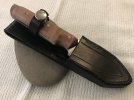- Joined
- Sep 22, 2017
- Messages
- 28
Hello forum members. First, let me say thanks to anyone who has contributed to these pages. I have absorbed a huge amount of information here and I hope I will gain the experience to help other beginners. That being said, I am a beginner myself. I have practiced some grinding and drilling on mild steel. I have a 1x30 with the Norton belts. No problem with the grinding. I also have a 5 speed bench top drill press. Again, no problem with the soft steel. Start with a punch than drill with a center drill. Step up to a 9/64 bit followed by a #24. Then I ream with a 5/32 carbide reamer. Perfect fit for my 5/32 SS pin stock. Practice went well and I moved on to a 5/32” piece of 01 ground flat stock. All good, nice shape, feels great in hand. Sharp alignment of plunge lines. Finished it down to 120 grit and anxiously did a HT in a forced air hardwood charcoal setup. Magnet test. Go a little past then quench in fresh canola oil. Passed file test and on to temper. Two 2 hours cycles in oven at 425 with cool in between. Everything looks and feels great. Feeling proud. Then I go to drill the pin holes. Darn it! Broke two center drills and barely made a divot. Tried carbid bits, diamond bits. No go. So, now I realize I probably should have drilled the holes before HT. So, here lies my question. I was planning on annealing the blade again by bringing just to magnetism loss and then turning off the air and letting it cool in the coals. Then I was going to drill the holes with the #24 and re-HT and temper. Once done, I plan on reaming with the 5/32 for sung pin fit. Will that work or should I ream before HT. I am worried the holes will change. Any advice, criticism or tasteless jokes will be appreciated.
Thanks
Thanks






